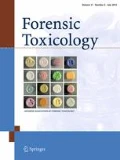Abstract
Botulinum neurotoxin (BoNT) is one of the most poisonous substances ever known. It is produced by Clostridium botulinum, which causes botulism, a persistent paralysis of peripheral nerve termini. Clostridium botulinum bacteria, the source of BoNTs, are widely distributed in the environment. BoNT poses a significant risk as a bioweapon and is classified as a Category A agent by the Centers for Disease Control and Prevention because of its ready availability and extreme potency. In this paper, a rapid and ultrasensitive method using a single-molecule array assay was developed for the quantitative analysis of BoNT serotype A1 (BoNT/A1), the most common toxin serotype. This method can detect as little as 400 fg/mL of solid powder toxin resulting in a broad quantitation range from 0.4 to 100 pg/mL and can be accomplished in approximately an hour. Additionally, to show that it would be useful for clinical samples during a potential exposure and to test for any possible matrix interference, the method was applied to the analysis of spiked human serum and urine samples. The limits of detection were 200 fg/mL for serum (in 25 % dilution) and 1.00 pg/mL for urine (in 10 % dilution), with sample quantitation ranges from 0.8 to 400 and from 10 to 1000 pg/mL, respectively.



References
Arnon SS, Schechter R, Inglesby TV, Henderson DA, Bartlett JG, Ascher MS, Eitzen E, Fine AD, Hauer J, Layton M, Lillibridge S, Osterholm MT, O’Toole T, Parker G, Perl TM, Russell PK, Swerdlow DL, Tonat K, Biodefense WGC (2001) Botulinum toxin as a biological weapon—medical and public health management. JAMA-J Am Med Assoc 285:1059–1070
St Louis ME, Peck SSH, Bowering D, Morgan GB, Blatherwick J, Banerjee S, Kettyls GD, Black WA, Milling ME, Hauschild AHW, Tauxe RV, Blake PA (1988) Botulism from chopped garlic: delayed recognition of a major outbreak. Ann Intern Med 108:363–368
Lindstrom M, Korkeala H (2006) Laboratory diagnostics of botulism. Clin Microbiol Rev 19:298–314
Tacket CO, Shandera WX, Mann JM, Hargrett NT, Blake PA (1984) Equine antitoxin use and other factors that predict outcome in type-a foodborne botulism. Am J Med 76:794–798
Mukherjee J, Tremblay JM, Leysath CE, Ofori K, Baldwin K, Feng X, Bedenice D, Webb RP, Wright PM, Smith LA, Tzipori S, Shoemaker CB (2012) A novel strategy for development of recombinant antitoxin therapeutics tested in a mouse botulism model. PLoS One 7:e29941. doi:10.1371/journal.pone.0029941
Kan CW, Rivnak AJ, Campbell TG, Piech T, Rissin DM, Mosl M, Peterca A, Niederberger HP, Minnehan KA, Patel PP, Ferrell EP, Meyer RE, Chang L, Wilson DH, Fournier DR, Duffy DC (2012) Isolation and detection of single molecules on paramagnetic beads using sequential fluid flows in microfabricated polymer array assemblies. Lab Chip 12:977–985
Gaylord ST, Dinh TL, Goldman ER, Anderson GP, Ngan KC, Walt DR (2015) Ultrasensitive detection of ricin toxin in multiple sample matrixes using single-domain antibodies. Anal Chem 87:6570–6577
Wilson DH, Rissin DM, Kan CW, Fournier DR, Piech T, Campbell TG, Meyer RE, Fishburn MW, Cabrera C, Patel PP, Frew E, Chen Y, Chang L, Ferrell EP, von Einem V, McGuigan W, Reinhardt M, Sayer H, Vielsack C, Duffy DC (2016) The Simoa HD-1 analyzer: a novel fully automated digital immunoassay analyzer with single-molecule sensitivity and multiplexing. J Lab Autom 21:533–547
Rivnak AJ, Rissin DM, Kan CW, Song L, Fishburn MW, Piech T, Campbell TG, DuPont DR, Gardel M, Sullivan S, Pink BA, Cabrera CG, Fournier DR, Duffy DC (2015) A fully-automated, six-plex single molecule immunoassay for measuring cytokines in blood. J Immunol Methods 424:20–27
Acknowledgments
This study was funded in part by the Defense Threat Reduction Agency (Contract Number W911SR-10-D-0011).
Author information
Authors and Affiliations
Corresponding author
Ethics declarations
Conflict of interest
The authors declare the following competing financial interest(s): David R. Walt is the scientific founder and a board member of Quanterix Inc. All remaining contributing authors declare no competing financial interests.
Ethical approval
Research does not involve human participants and/or animals. Unidentified human serum and urine samples were purchased commercially. No informed consent was needed by researchers, according to the guidelines of National Institutes of Health (NIH).
Rights and permissions
About this article
Cite this article
Dinh, T.L., Ngan, K.C., Shoemaker, C.B. et al. Rapid and ultrasensitive detection of botulinum neurotoxin serotype A1 in human serum and urine using single-molecule array method. Forensic Toxicol 35, 179–184 (2017). https://doi.org/10.1007/s11419-016-0336-7
Received:
Accepted:
Published:
Issue Date:
DOI: https://doi.org/10.1007/s11419-016-0336-7

